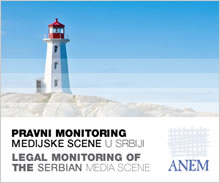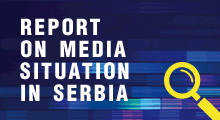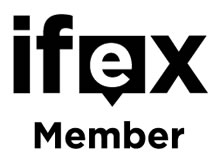15. 05. 2015
5th ANEM SEMINAR ON THE IMPLEMENTATION OF NEW MEDIA LAWS

After the introductory word by representatives of ANEM and OSCE, the seminar was opened by attorney at law Miloš Stojković, member of the ANEM legal team, who was also the moderator of the event. Along with Miloš Stojković, the panelists were: Saša Mirković, state secretary at the Ministry of Culture and Information, Zoran Pavić, director of the communications sector of the Privatization Agency, Rajka Galin Ćertić, assistant director for legal affairs, the Regulatory Authority of Electronic Media, and Rade Veljanovski, media expert and professor at the Faculty of Political Sciences, Belgrade.
At the beginning of the seminar Miloš Stojković outlined key solutions of the Law on Public Information and Media and the Law on Electronic Media.
The Law on Public Information and Media is an umbrella law that comprises general rules for all media, regardless of the platform used for information distribution, i.e. for providing media service. The Law introduces novelties regarding definition of media and the answer to the question as to who may be media founder. For the first time it establishes rules pertaining to the public interest in the public information sector, as well as to regulating the manner of state participation in media financing by means of project-based co-financing. The Law also envisages mandatory privatization of all the remaining publicly owned media by 1 July 2015. Important characteristics of media as means of imarting information, according to legal definition, are that the media convey content using words, images and/or sound, that the content conveyed in this manner is editorially shaped and that it is is intendend for public distribution to an indefinite number of recipients. Also, the Law states that the media are traditional print and electronic media, news agencies and web presentations of traditional media, as they meet all the three above stated criteria. On the other hand, internet-based communication channels are not media as they lack editorially shaped content. Therefore, the legal definition differentiates between editorially shaped content and content shaped by users. The media are not separate legal entities according to this Law, and they must have a publisher (in the terminology of the former law: founder). The important difference to the old law is that the publisher may be a natural person, under the condition that the person is registered as entrepreneur. Unlike the former law, where the founder was not allowed to dispose with the rights on the media, the new law excplicitly states that the publisher may transfer its right to media publishing to another person.
The bulk of the novelties that the Law brings pertain to introducing rules on co-financing of projects of public interest. Public interest in the public information sector is legally defined and realized in several ways: institutionally (through public service broadcasters at the national level and the level of the autonomous province), through the media in the languages of national minorities (by providing national councils of national minorities with an opportunity to found legal persons that may be media publishers, while preserving the independence of editorial policy), by founding a legal person for informing the public on the territory of Kosovo, and the most important (and the only) financial form of state participation in the media is co-financing of projects of public interest. Along with defining rules on state aid to the media, changes are visible regarding the Media Register that, unlike the former one, contains information on media ownership, the amount of state aid and other information of importance to users who can thus assess the relevance of information they receive from the media. Entering information into the Register is not obligatory, but if it is not done - the publisher is prevented from participating in public calls for co-financing of projects in the public interest; the additional restriction is that such media will not be able to feature advertisement by bodies of public authorities and public enterprises. The Law also specifies rules regarding media concentration, which rules are significantly more liberal. Horizontal integration is permitted, and the criterion for merging multiple electronic media publishers are ratings within the relevant zone of coverage, which ratings, when combined, do not exceed 35% in the calendar year preceeding the merger; the criterion for print media is realized circulation. Vertical integration is not legally forbidden, although the first version of the draft Law on Electronic Media contained such restriction for electronic media. However, there is a certain restriction stating that the media distributer, if it also deals in the activity of media publishing, shall be obligated to carry out media publishing activities through an affiliated legal person. Cross-media integration, i.e. merger of multiple publishers of electronic and print media, is also permitted under certain conditions. As for the freedom of expression, it must be noted that there have been no major changes considering that Serbia has been a member of the Council of Europe since 2003 and a signatory of the European Convention for the Protection of Human Rights and Fundamental Freedoms, the article 10 of which is important for this subject matter. The key principles of the Convention were transposed into the Constitution of the Republic of Serbia, and the new Law does not diverge from that framework. However, it attempts to specify some already existing rules in order to overcome problems identified in practice. This pertains, in particular, to court proceedings related to compensatory damages for publishing information harming someone's rights and reputation. The essence of the compensatory damages should be an adequate satisfaction for violated honor and reputation, which should not automatically mean material satisfaction only. In that sense, the Law specifies that the courts on the territory where the publisher's seat is, i.e. on the entire territory of Serbia, are competent for media-related proceedings, while the law regulating the competence of courts envisages exclusive competence of the High Court in Belgrade. It is up to the practice to resolve which of the two solutions is to be implemented when deciding on the competence.
The Law on Electronic Media is an entirely new law that is harmonized with the rules valid in the unified European market, i.e. with the the European Audiovisual Media Services Directive. This law brings significant novelties compared to the earlier Law on Broadcasting considering that it was necessary to adjust the media sector to technological changes and redefine the obligations of media service providers, as well as regulate the position of the independent regulator. Inter alia, the Law contains numerous provisions on the independent regulatory body (Regulatory Authority of Electronic Media - REM). It envisages general independence of the regulatory body, but also diminishes this independence, primarily by prescribing that key documents of the regulatory body require the control of legality and constitutionality by competent ministry, and the agreement of legislative and executive bodies. Additionally, REM employees have the status of civil servants, which additionally complicates the issue of independence. The Law also introduces new measures that the regulatory body may pronounce. As for the media service providers, the bulk of novelties pertain to audio-visual commercial communication (TV advertising, TV sales, product placement etc.), where the rules are specified on the means of advertising and permitted advertising in electronic media.
Saša Mirković talked about the activities of the Ministry of Culture and Information regarding the implementation of new media laws. As for the project-based co-financing, he stressed that the procedure pertaining to the calls for proposals issued by the Ministry has been completed - the call was issued, the projects were collected, the expert selection panels were selected and they held sessions; what remains to be done is reaching decisions, signing contracts and finally transferring funds. Among other activities related to the implementation of media laws, Mirković singled out the election of the director general of Radio Television of Serbia (RTS), done within legal deadline, thus respecting the legal procedure envisaged by the Law on Public Service Broadcasters. Mirković underscored that entering information on the media in the Media Register began in February, to be ended in mid-August. Entering information in the Media Register is not obligatory, but it is desirable since those who do not enter information will not be able to apply to public competitions nor will it be possible for them to obtain legal forms of state aid. According to the latest data on the number of registered media (before the Media Register became operational), there are 1441 media in Serbia. Current data will be known after the deadline for entering information in the Media Register. Only then can an adequate analysis be done showing the direction in which the media sector is going. Media are currently interested in the privatization of the remaining publicly owned outlets, so it is not realistic to expect the process of entering information in the Media Register to be completed before the very last privatization is done. Adopting the Law on Electronic Media was a precondition for digitalization of terrestrial television. The process is conducted by the responsible ministry (Ministry of Trade, Tourism and Telecommunications) and it is expected that the deadline (17 June 2015) will be met. Very important processes for the media sector take place in 2015, such as digitalization and privatization. Since the new media laws were adopted after no less than 11 years, numerous problems accumulated during this time, and many problems that remained unresolved for years are solved now, such as privatization (that had to be completed by the end of 2007).
Zoran Pavić pointed out that the privatization process faces numerous limitations. Despite the efforts of the Privatization Agency to create conditions for unhindered course of the process and to complete it within legal deadline, there are numerous problems in the privatization of remaining publicly owned media, primarily due to tardiness of media and local self-governments as founders of these media. The media had to submit privatization documentation, including the assessment of the capital value, while local self-governments were obliged to pass decisions on the methods of media privatization. However, adopted decisions were often not correct - formally and essentially - and the Agency was forced to return them to local self-governments for repeated adoption and amendments. The Agency has been working intensively on the completion of documentation for issuing public calls for all the media that this is possible to do for at this moment, which is some 30 media, according to Pavić, although the situation changes from day to day. By mid-May first public calls will be issued for as many media as possible. The Agency will do everything in its power and use the shortest possible deadlines in order to complete the process by 1 July 2015. If the privatization is unsuccessful, what follows is distribution of free shares of the media to their employees, and if the employees do not accept the shares, local self-governments will have to pass a decision on the change of publisher's activity or they will go into bunkruptcy, which leads to deleting the media from the Media Register. Pavić appealed on the media and local self-governments to fulfill their obligations as soon as possible (submitting of documentation) so that the privatization process could be unhindered, i.e. so that it could be continued by issuing public calls.
Rajka Galin Ćertić talked about the implementation of the Law on Electronic Media and the position of the regulatory body regarding the new media laws, as well as the obligations of media service providers. The Republic Broadcasting Agency changed its name into the Regulatory Authority of Electronic Media (REM). The change of the name should reflect to an extent the changed nature of regulation and the domain of electronic media. Unfortunately, despite proclaimed independence, some provisions of the very law bring the independence into question. The regulatory body has to adopt a large number of bylaws that will further elaborate the Law on Electronic Media. Some of the bylaws have already been through public debate, but it has to be noted, unfortunately, that representatives of electronic media have not taken part in these to the extent that was neeeded, which is probably a consequence of the prevalence of the digitalization process and the extension of licenses. REM issued several decisions on the right to access multiplex. Local and regional televisions will get a significantly larger zone of coverage and the question is whether such televisions will be able to adapt their program to these zones and fulfill their financial obligations. REM is bound by established zones of coverage and the manner of filling in the multiplex (prescribed by the rulebook on the digital switchover), which specifically means that the first multiplex is filled by public service broadcasters and national broadcasters, while the second multiplex is filled by regional and local broadcasters of television program. Programs of the Radio Television of Serbia (RTS), Radio Television of Vojvodina (RTV) and the national commercial broadcasters are entitled to acccess to the first multiplex, while regional and local broadcasters are entitled to the second multiplex, but it should be noted that in the logical numeration (the layout of the channels on remote control devices) the criterion of the time of issuing the license for regional TVs is taken into account. According to the current regulation, the third multiplex would be filled in the same way as the first two, based on a public call. As there are free spaces in the second multiplex at the moment, the third has not been taken into account yet. What should be stressed are significantly larger expenditures for broadcasters after digital switchover. In order to allow broadcasters to adjust to the changes, the Public Enterprise „Broadcasting Technics and Links" (Javno preduzeće „Emisiona tehnika i veze" - ETV) established a grace period in the price list during which the fees for signal distribution will be lower, and REM will not increase its fees in the same period. Fees paid to collective organizations for the protection of copyright and related rights (SOKOJ, OFPS and PI) are also sizable expenditures for broadcasters. Regarding that, REM will try everything within its competence to make the fees acceptable. Also, at the moment of the expiration of existing licenses, broadcasters will have to adjust their studies of programming to the zone where they will be seen, and that will be one of the conditions for the extension of license. It should be made clear that the processes of digitalization of television and radio are separate since the process of digitalization of radio is at inception, not only in Serbia, but also in Europe, and it does not lead to significant changes in the quality if compared to the changes in television broadcasting. Television media service providers should be aware that licenses for regional and local coverage expire in 2016 and 2017. As the zone of coverage is increased for the existing broadcasters, they have to produce program that will cover the entire zone, which significantly increases expenses. However, the new law does not limit program networking, and so the broadcasters should take this possibility into account as it could ensure their survival in the new technical and market conditions.
As for programming obligations, they are numerous and a large number of rulebooks was passed - media service providers should pay particular attention to those that specify obligations in media service provision pertaining to the protection of minors and dignity of persons. Certain measures may be pronounced to media service providers for failure to comply with these obligations. A new measure of temporary ban on broadcasting of certain programming content during 30 days replaced the former measure of temporary revocation of license.
Rade Veljanovski pointed out that the work on the new media laws is a continuation of necessary harmonization with the European experience and standards. The European media policy, as the key standard, envisages the need to distance the media from power centers (politics, business etc.) that may influence media content in any way. Public interest is a general one, i.e. the interest of all citizens. It can be realized by all media, including commercial media and public service broadcasters. It is a misconception that commercial media are not capable of realizing public interest since the public interest is determined by the adequacy of content. Project-based co-financing is of great importance for the fulfillment of the cutting-edge media policy. Even then the important issue is how to exercise regulation without imposing influence. The issue is one of the essential tests of democracy. For the first time, the new laws provide a list of what is public interest in the public information sector. Public interest defined in this manner is also financed by expenditures from public funds. One of the questions that marked the public debate on draft media laws is the question of the amount of public funds for this purpose. The most logical answer is that the funds for project-based co-financing should be at least equal to the amount of former direct funding of the media in the status on public companies (before the adoption of the new media laws).
After the panelists' presentations, a debate was opened where the participants were able to ask questions. As expected, the majority of questions pertained to privatization related issues. There were questions regarding the fate of companies in the case of failed privatization, the survival of public information in the languages of national minorities, and other questions, as follows:
1. If the privatization procedure fails, is it possible to change the activity of the company so that it becomes a service enterprise that would perform technical activities regarding publishing or broadcasting program, while the production would be taken over by other legal persons?
The response of the panelists can be summed up as follows: the state (any public entity) cannot be a founder at any level of authority. However, as the legal provision that prescribes this is currently undergoing constitutionality assessment before the Constitutional Court, the decision of the court should be taken into account prior to the final answer to this question.
2. Is there a way to continue with broadcasting media content on Radio Subotica if it would remain the city property regarding technical resources, while the production would be performed by institutions established by national councils?
As a municipality cannot own the media, such arrangement is not possible, but it is possible to make an arrangement with the new owner of Radio Subotica.
3. Do the panelists support the initiative for the Law on Local Public Media Services?
A panelist stated that such an idea used to exist, but it was rejected as it was assessed (and now it is entirely clear) that there are no conditions for establishing public service media, not even at the regional level, because, among other things, the state cannot support such costs and it is not realistic to expect that citizens would be prepared to participate with a new form of fee, especially in the current crisis (citizens of local communities where there would be such media would pay the fee in addition to the fee for the national public service broadcaster).
4. What would happen in the case that the privatization process is initiated, but not finalized by 30 June 2015?
The response was that the Privatization Agency passes a decision on the termination of privatization, followed by a procedure of distribution of free-of-charge shares to employees. If this fails, a decision is passed on the change of activity. The worst case scenario is bankruptcy of the publisher. In both cases the medium is deleted from the Media Register.
5. Are there some preferential conditions under which the institutions of national councils would get a frequency?
The response was that frequency is a limited resource and that a license for it cannot be obtained solely on the basis of public competition. The Council of the Regulatory Authority of Electronic Media (REM) decides if someone will get a license. On the other hand, Article 72 of the Law on Electronic Media envisages benefits for such media regarding paying fees, but the license is obtained only when there is a free frequency. After the sales is conducted, REM will monitor the program and if it is established that a buyer does not adhere to programming study and that the media outlet does not feature program in the languages of national minorities, a breach of Contract on the sales of state capital will be established, which will be the basis for termination of contract.
The participants also pointed out a problem in the privatization process. Media representatives stated that it seems that the initial price was set too high (100% of the estimated value), and many employees, according to a new Regulation, will not obtain the right to register free-of-charge shares considering that they had already exercised their right to register shares of other, already sold public enterprises.

The views and opinions presented at the seminar do not necessarily reflect the views of the Embassy of the Kingdom of the Netherlands.
-
Photo: ANEM
-
Photo: ANEM
-
Photo: ANEM
-
Photo: ANEM
-
Photo: ANEM
-
Photo: ANEM
-
Photo: ANEM
-
Photo: ANEM
-
Photo: ANEM
-
Photo: ANEM
-
No comments on this topic.





